
Advertisement, E. J. Miller & Son, 65 (later 317) King Street, Alexandria Gazette, September 16, 1893, suppl. ed. (Courtesy, Alexandria Library, Special Collections.). The advertisement states: “R. H. Miller commenced business in 1822 in one half of the present store. No change was made in the firm until 1857, when he rebuilt the store as at present.” Apparently the store was rebuilt earlier, however, as the November 7, 1856, Alexandria Gazette reports a “new and spacious warehouse recently erected” on the site.
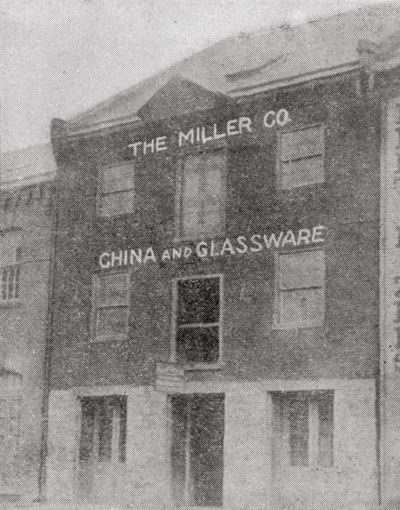
Photograph, Miller Company, 31 (now 119) King Street, 1907. Reproduced in Alexander J. Wedderburn, Souvenir Virginia Tercentennial, 1607–1907, of Historic Alexandria, Virginia (Alexandria, Va.: A. J. Wedderburn, 1907). The caption reads, “This firm is old and reliable, having been established in 1822. Another Alexandria institution.”

Engraving, R. H. Miller & Sons, 11 & 13 North Second Street, St. Louis, 1862. (Courtesy, Missouri History Museum, St. Louis.) Depicted is the third location of R. H. Miller & Sons, taken from a company receipt dated October 16, 1862. The address, no longer extant, is now within the confines of a waterfront park.

Engraving, R. H. Miller & Sons, 121 Fourth Street, 1862. (Courtesy, Missouri History Museum, St. Louis.) This fourth location of the company—in what was known as the Collier Marble Buildings—was taken from a company receipt dated May 16, 1862. By 1867 the address appears as 504 North Fourth Street.

Receipt, Miller & Brother, “Successors to R. H. Miller & Sons,” dated June 8, 1867. (Courtesy, Missouri History Museum, St. Louis.)
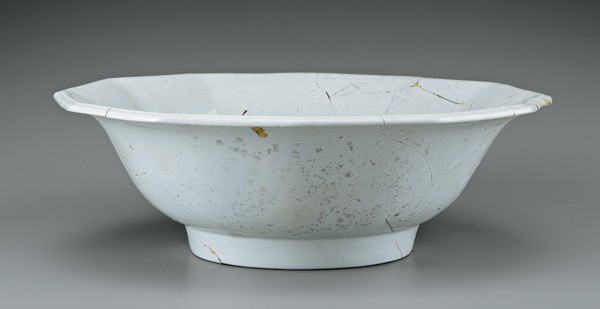
Wash basin, Joseph Heath, England, 1848–1853. White ironstone. D. 13 1/2". Marks: printed on the underside, “MANUFACTURED FOR R-H MILLER & CO ST. LOUIS. M / IRONSTONE CHINA / J. HEATH.”; impressed under the printed mark, “PEARL WARE / J. HEATH.” (Courtesy, Alexandria Archaeology Museum; photo by Gavin Ashworth.) This wash basin was found in a privy behind a house at 809 Duke Street, Alexandria.

Mark on the underside of the wash basin illustrated in fig. 6.
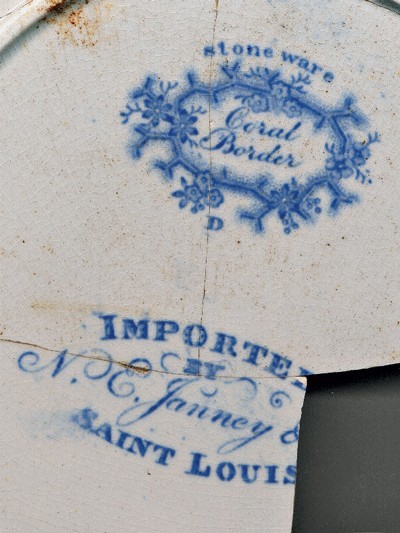
Plate, Thomas Dimmock (Junr) & Co. manufactory, Shelton, England, ca. 1835–1848. Ironstone, with transfer-printed Coral Border pattern. D. 10". Mark: printed on the underside, “stone ware / Coral Border / IMPORTED / BY / N. E. Janney & [Co.] / SAINT LOUIS” (Photo, Sangamo Archaeological Center.) Thomas Dimmock used similar manufacturer marks between 1828 and 1859, but this version limits the date. The plate was found in excavations in Mobile, Alabama, in an 1840s context.
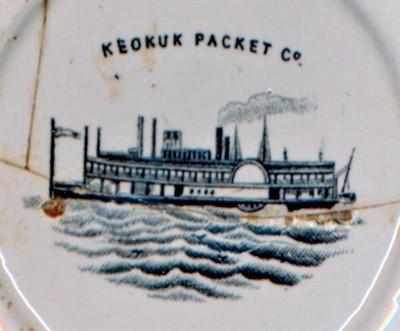
Saucer, James Edwards, England, ca. 1857–1865. White granite. D. 6 1/2". Marks: above transfer print, “KEOKUK PACKET CO.”; impressed on underside, “JAS. EDWARDS & SON / DALEHALL”; (printed), “IMPORTED / BY. / R. H. MILLER & SONS. / ST LOUIS MO.” (Photo, Sangamo Archaeological Center.) Archaeologists recovered this saucer from an 1850s context in St. Louis. Steamboats were vital to the city’s economy until they were overtaken by the railroads. This saucer may have been used on a steamboat traveling the 214 miles between St. Louis and Keokuk.

Marks on the underside of the saucer illustrated in fig. 9.
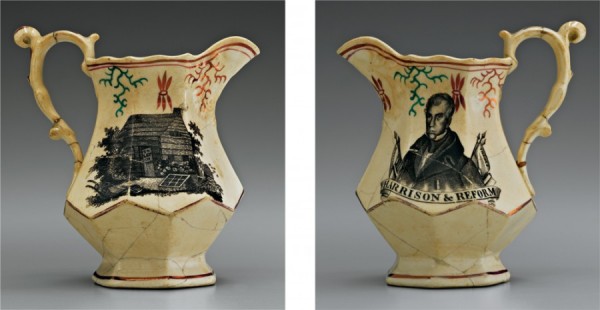
Pitcher, unknown maker, England, 1840. Bone china with overglaze transfer prints embellished with green enamel and purple luster. H. 5 1/8". Mark: “MANUFACTURED / for Robt.. H · Miller. / ALEXANDRIA. / D-C” (Courtesy, The Lyceum: Alexandria’s History Museum; photo, Gavin Ashworth.) This pitcher was imported by Robert H. Miller for the presidential campaign of William Henry Harrison. To the right of the handle is a log cabin with a plow, sheaves of wheat, a beehive, and a sign “TO LET IN 1841”; to the left is a portrait above a ribbon, labeled “HARRISON & REFORM,” flanked by cannons and flags marked “Tippecanoe” and “Thames,” references to Harrison’s famous military victories. The same prints, published by J. S. Horton of Baltimore and in the collection of the Library of Congress, American Political Prints 1766–1876, appear in green on other pitchers and plates manufactured for Miller and on a Whig campaign ribbon produced for the Young Men’s National Convention held in Baltimore on May 4, 1840.
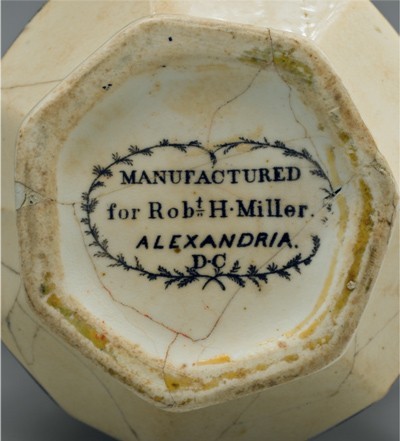
Mark on the bottom of the pitcher illustrated in fig. 11. The printed mark has been found on other styles of Harrison campaign china.

Jar rims, B. C. Milburn (for E. J. Miller), Alexandria, Virginia, 1865–1876. Salt-glazed stoneware. These sherds, recovered from the waster pile at the Wilkes Street Pottery, are stamped “E. J. MILLER / ALEXA.” Robert H. Miller and his son E. J. ordered stoneware from the pottery from the 1820s until it closed, in 1876.

Jar, probably James Hamilton, Greensboro, Pennsylvania, ca. 1877–1900. Salt-glazed stoneware. H. 11 1/2". Mark: stenciled “E. J. MILLER & CO. / QUEENSWARE / ALEXANDRIA. VA. / 2” (Courtesy, The Lyceum: Alexandria’s History Museum; photo, Gavin Ashworth.) This two-gallon vessel with stenciled decoration and Albany slip interior is typical of the production of James Hamilton and others in the Greensboro–New Geneva region. Such items were sold at E. J. Miller’s store after Alexandria’s Wilkes Street Pottery closed in 1876.

Crucibles, possibly German, ca. 1823–1827. Earthenware with black sand and lead inclusions. H. of tallest 1 3/4". (Courtesy, Alexandria Archaeology Museum; photo, Gavin Ashworth.) Miller advertised crucibles at least seven times between 1822 and 1847. These crucibles were found across the street from Miller’s shop on a property occupied from 1823 to 1848 by Alexandria silversmith John Adam. They were found along with debris from an 1827 fire.

Teacup and saucer, English, ca. 1820s. Pearlware, transfer-printed. D. of teacup 3 1/2"; D. of saucer 5 1/2". Mug, English, ca. 1845–1865. Ironstone with flow-blue transfer-printed design. D. 3 1/4". Teacup, English, ca. 1830s–1860s. Whiteware, blue sprigged-thistle design. D. 3 1/4". (Courtesy, Alexandria Archaeology Museum; photo, Gavin Ashworth.) Miller offered for sale “blue printed (Liverpool) wares,” “flown” or “flowing blue” wares, and China tea sets described as having “pure white, blue raised figures.” The pearlware teacup and saucer and the ironstone mug were excavated from a residential property at 104 S. St. Asaph Street, Alexandria. The whiteware teacup is from a neighboring property, 522–524 King Street.
